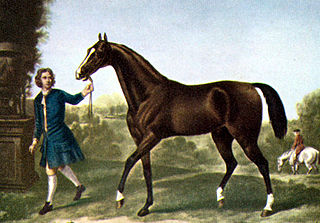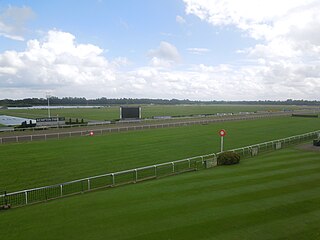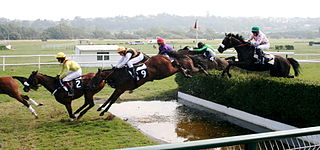Related Research Articles

The St Leger Stakes is a Group 1 flat horse race in Great Britain open to three-year-old thoroughbred colts and fillies. It is run at Doncaster over a distance of 1 mile, 6 furlongs and 115 yards, and it is scheduled to take place each year in September.

Horse racing is the second largest spectator sport in Great Britain, and one of the longest established, with a history dating back many centuries. According to a report by the British Horseracing Authority it generates £3.39 billion total direct and indirect expenditure in the British economy, of which £1.05 Billion is from core racing industry expenditure and the major horse racing events such as Royal Ascot and Cheltenham Festival are important dates in the British and international sporting and society calendar.

The Darley Arabian was one of three dominant foundation sires of modern Thoroughbred horse racing bloodstock. The other two founders were the Godolphin Arabian and the Byerley Turk. This bay Arabian horse was bought in Aleppo, Syria, by Thomas Darley in 1704 and shipped back to Aldby Park in England, as a present for his brother.

The Godolphin Arabian, also known as the Godolphin Barb, was an Arabian horse who was one of three stallions that founded the modern Thoroughbred. He was named after his best-known owner, Francis Godolphin, 2nd Earl of Godolphin.
In horse racing in the United Kingdom, France and Republic of Ireland, National Hunt racing requires horses to jump fences and ditches. National Hunt racing in the UK is informally known as "jumps" and is divided into two major distinct branches: hurdles and steeplechases. Alongside these there are "bumpers", which are National Hunt flat races. In a hurdles race, the horses jump over obstacles called hurdles; in a steeplechase the horses jump over a variety of obstacles that can include plain fences, water jump or an open ditch. In the UK the biggest National Hunt events of the year are generally considered to be the Grand National and the Cheltenham Gold Cup.

York Racecourse is a horse racing venue in York, North Yorkshire, England. It is the third biggest racecourse in Britain in terms of total prize money offered, and second behind Ascot in prize money offered per meeting. It attracts around 350,000 racegoers per year and stages three of the UK's 36 annual Group 1 races – the Juddmonte International Stakes, the Nunthorpe Stakes and the Yorkshire Oaks.

Newmarket Racecourse is a British Thoroughbred horse racing venue in Newmarket, Suffolk, comprising two individual racecourses: the Rowley Mile and the July Course. Newmarket is often referred to as the headquarters of British horseracing and is home to the largest cluster of training yards in the country and many key horse racing organisations, including Tattersalls, the National Horseracing Museum and the National Stud. Newmarket hosts two of the country's five Classic Races - the 1,000 Guineas and 2,000 Guineas, and numerous other Group races. In total, it hosts 9 of British racing's 36 annual Group 1 races.

Kempton Park Racecourse is a horse racing track together with a licensed entertainment and conference venue in Sunbury-on-Thames, Surrey, England, 16 miles south-west of Charing Cross, London and on a border of Greater London. The site has 210 acres of flat grassland surrounded by woodland with two lakes in its centre. Its entrance borders Kempton Park railway station which was created for racegoers on a branch line from London Waterloo, via Clapham Junction.

A steeplechase is a distance horse race in which competitors are required to jump diverse fence and ditch obstacles. Steeplechasing is primarily conducted in Ireland, the United Kingdom, Canada, United States, Australia, and France. The name is derived from early races in which orientation of the course was by reference to a church steeple, jumping fences and ditches and generally traversing the many intervening obstacles in the countryside.
The Craven Stakes is a Group 3 flat horse race in Great Britain open to three-year-old colts and geldings. It is run over a distance of 1 mile (1,609 metres) on the Rowley Mile at Newmarket in mid-April.

Nottingham Racecourse is a thoroughbred horse racing venue located in Nottingham, Nottinghamshire, England. It is situated at Colwick Park, close to the River Trent and about 3 km east of the city centre.

Taunton Racecourse is a thoroughbred horse racing venue located in Orchard Portman, two miles south of Taunton, Somerset, England. Opened in 1927, Taunton is the youngest National Hunt course in England, and the last racecourse to be opened in Britain until Great Leighs in 2008.

Flying Childers was a famous undefeated 18th century thoroughbred racehorse, foaled in 1714 at Carr House, Warmsworth, Doncaster, and is sometimes considered as the first truly great racehorse in the history of thoroughbreds and the first to catch the public imagination.

Matchem, sometimes styled as Match 'em, was a Thoroughbred racehorse who had a great influence on the breed, and was the earliest of three 18th century stallions that produced the Thoroughbred sire-lines of today, in addition to Eclipse and Herod. He was the Leading sire in Great Britain and Ireland from 1772 - 1774.

Horseracing in Scotland is a popular spectator sport, with a history dating back over 900 years. There are currently five operating racecourses in Scotland - one exclusively for flat racing, two exclusively for jump racing and two mixed. Between them they held one hundred and three race meetings in 2014. The main National Hunt meeting held is the Scottish Grand National meeting at Ayr each April, and the main Flat meeting is the Ayr Gold Cup Festival, at the same course each September.
The 1849 Grand National Steeplechase was the 11th official annual running of a handicap steeplechase horse race at Aintree Racecourse near Liverpool on Wednesday, 28 February. It attracted a field of twenty-four competitors for a prize valued at £825.
Sir Thomas was a British Thoroughbred racehorse. In a career that lasted from October 1787 to May 1790 he ran thirteen or fourteen times and won nine or ten races. In 1788 he became the first horse owned by a member of the British Royal Family to win The Derby, having been bought as a two-year-old by the Prince of Wales who later became King George IV. Following his win in the Derby, Sir Thomas raced in the Prince's ownership with some success until 1790.

Grey Momus was a British Thoroughbred racehorse and sire. In a career that lasted from August 1837 to 1839 he competed twenty-one times and won fourteen races. Grey Momus first attracted attention as a two-year-old when he recorded two impressive victories at Goodwood in August. In the following year he won seven times from nine starts, taking two of the year's biggest races, the 2000 Guineas at Newmarket and the Gold Cup at Ascot. Grey Momus won one competitive race and took three walkovers in 1839 before being retired. He was exported to stand as a stallion in Germany, where he had some success as a sire of winners.

Leith Races were the most important horse racing event in Scotland in the eighteenth century. They took place on the sands to the east of the harbour at Leith, near Edinburgh from 1504 to 1816. They first gained popularity through the patronage of the Duke of Albany, the future James VII and II, while he was Royal Commissioner at the Palace of Holyrood. Their exact date of origin had been lost by the mid-19th century but there is reference in the accounts of James IV's personal expenditure to a payment made in 1504 to a jockey, "the boy that ran the King’s horse", at Leith. There is also reference to them in the memoirs of the Earl of Huntly in 1591. From the Restoration until 1816, the races took place annually with very little intermission.
References
- ↑ Barrett 1995, p. 10.
- ↑ Whyte 1840, pp. 190–191.